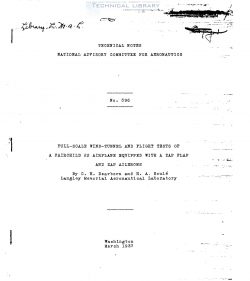naca-tn-596
- Version
- 133 Downloads
- 1.23 MB File Size
- 1 File Count
- November 25, 2016 Create Date
- November 25, 2016 Last Updated
National Advisory Committee for Aeronautics, Technical Notes - Full Scale Wind Tunnel and Flight Tests of a Fairchild 22 Airplane Equipped with a Zap Flap and Zap Ailerons

A wing equipped with a Zap_flap and Zap ailerons was
tested on a Fairchild 22 airplane in the fuIILscale wind
tunnel and in flight to determine the effect of the flaps
and ailerons on the performance and the control character-
istics of the airplane. The flaps were 0CV0"6f the Wing _"
chord and 0.83 of the wing span. Two sets of ailerons hav;
ing equal areas but different proportions were_tested, one
set being O;56 of the semispan and 0.18 of the chofd‘afid the_
other set being 0.46 of.the semispan and 0.22 of the chofd:
The wind—tunnel tests Showed that, when the ailerons
and horizontal tail surfaces were removed, the flaps ifl¥""' 11?
creased the maximum lift coefficient from 1.48 to 2.39. _ l93
In flight, the fully deflected flaps decreased the minimum
speed from 48.2 to 58.8 miles per hour. The take—off and' '
landing distances were both reduced by the flaps. The wind—
tunnel tests showed the ailerons to increase the drag_coef— ”
ficient, at a lift coefficient and Reynolds—Kumher'corre- ”
spending to the high speed of the airplane, from 0.0432 to
0.0498 and 0.0514, the 0.46 semispan ailerons giving the '
highest drag. In the flight tests both sets of aileréhs
were_found to give satisfactory rolling action in the nor—
mal—flight range. They required relatively large stick
forces for their operation, however', and the variation "of
the forces with aileron deflection was not linear.
At the request of the Bureau of Aeronautics, Navy De—
partment, the National Advisory Committee for Aeronautics
is conducting a series of tests of different types of
flapped wings on a FairchildlEB airplane. The tests con~
sist of the measurement in the full-scale wind tunnel of
the primary aerodynamic characteristics of the airplane
with each type of flap and, in flight, of the determina-
tion of the take-off, landing, and other characteristics
not readily determined in the wind tunnel. The results
from the-Fowler—wing tests are given in reference 1. The
present paper deals with the results of the tests of the
Zap wing.
| File | Action |
|---|---|
| naca-tn-596 Full Scale Wind Tunnel and Flight Tests of a Fairchild 22 Airplane Equipped with a Zap Flap and Zap Ailerons.pdf | Download |
Comment On This Post